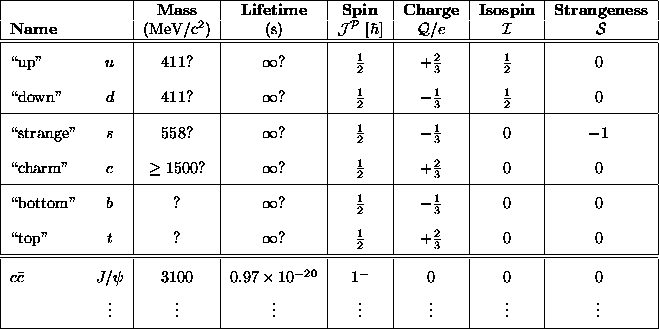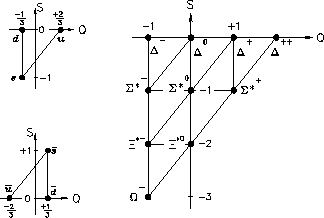Next: Colour
Up: Particle Taxonomy
Previous: Hadrons
Fair enough, obviously these symmetries were trying
to tell us something about the composition of hadrons. What?
Well, needless to say, Gell-Mann did not immediately
come up with a simple nuts-and-bolts assembly manual;
instead, they developed an abstract mathematical description
called  analogous to the description of spin
for electrons,
analogous to the description of spin
for electrons,  . [If you're interested, the
acronym stands for Simple Unitary group of order 2 or 3.]
I won't attempt to elaborate, but you can see why something
like this was needed - as for the
. [If you're interested, the
acronym stands for Simple Unitary group of order 2 or 3.]
I won't attempt to elaborate, but you can see why something
like this was needed - as for the  component of
spin, the projections of the three
component of
spin, the projections of the three  operators
along God-only-knows what axes in God-only-knows what
dimensions
operators
along God-only-knows what axes in God-only-knows what
dimensions cannot have a continuum of possible values but only a fixed
number of discrete or quantized values.
What is actually refers to is totally unknown.
Or, more properly, it refers to just what it says; if that
means nothing to us, well, that's just because our empirical
personal experience of the space of
cannot have a continuum of possible values but only a fixed
number of discrete or quantized values.
What is actually refers to is totally unknown.
Or, more properly, it refers to just what it says; if that
means nothing to us, well, that's just because our empirical
personal experience of the space of  is so limited
that we don't relate to it very well. What do ``normal''
space and time actually refer to?
is so limited
that we don't relate to it very well. What do ``normal''
space and time actually refer to?
Anyway, someone inevitably formulated a simpler instruction manual
for assembling hadrons. This was to give the requisite properties
to three (there are more now, but hold off on that) really
fundamental component particles called
`` quarks.'' All mesons are composed of a quark-antiquark pair
whereas baryons are composed of three quarks
held together by a `` superstrong'' force mediated by
a new type of intermediary called `` gluons'' (g)
[more cuteness, but who can argue...].
All mesons are composed of a quark-antiquark pair
whereas baryons are composed of three quarks
held together by a `` superstrong'' force mediated by
a new type of intermediary called `` gluons'' (g)
[more cuteness, but who can argue...].

Table:
The known (or suspected) ``generations'' of quarks
All quarks have a ``baryon number''  as well as fractional electric charge
because it takes 3 to make one baryon.
The ``hypercharge''
as well as fractional electric charge
because it takes 3 to make one baryon.
The ``hypercharge''  of any particle is the sum of
its baryon number and its strangeness:
of any particle is the sum of
its baryon number and its strangeness:  .
For each quark there corresponds an antiquark
of the same mass, spin, parity and isospin,
but with opposite values of electric charge, strangeness,
baryon number and hypercharge.
.
For each quark there corresponds an antiquark
of the same mass, spin, parity and isospin,
but with opposite values of electric charge, strangeness,
baryon number and hypercharge.

Figure:
Upper left: the three lowest-mass quarks.
Lower left: the corresponding antiquarks.
Right: the spin- baryons.
The
baryons.
The  (strangeness -3) was predicted by
a ``quark content'' analysis and later found experimentally,
convincing everyone that the
(strangeness -3) was predicted by
a ``quark content'' analysis and later found experimentally,
convincing everyone that the  model was correct.
model was correct.
Next: Colour
Up: Particle Taxonomy
Previous: Hadrons
 analogous to the description of spin
for electrons,
analogous to the description of spin
for electrons,  . [If you're interested, the
acronym stands for Simple Unitary group of order 2 or 3.]
I won't attempt to elaborate, but you can see why something
like this was needed - as for the
. [If you're interested, the
acronym stands for Simple Unitary group of order 2 or 3.]
I won't attempt to elaborate, but you can see why something
like this was needed - as for the  component of
spin, the projections of the three
component of
spin, the projections of the three  operators
along God-only-knows what axes in God-only-knows what
dimensions
operators
along God-only-knows what axes in God-only-knows what
dimensions is so limited
that we don't relate to it very well. What do ``normal''
space and time actually refer to?
is so limited
that we don't relate to it very well. What do ``normal''
space and time actually refer to?

 as well as fractional electric charge
because it takes 3 to make one baryon.
The ``hypercharge''
as well as fractional electric charge
because it takes 3 to make one baryon.
The ``hypercharge''  of any particle is the sum of
its baryon number and its strangeness:
of any particle is the sum of
its baryon number and its strangeness:  .
For each quark there corresponds an antiquark
of the same mass, spin, parity and isospin,
but with opposite values of electric charge, strangeness,
baryon number and hypercharge.
.
For each quark there corresponds an antiquark
of the same mass, spin, parity and isospin,
but with opposite values of electric charge, strangeness,
baryon number and hypercharge.

 baryons.
The
baryons.
The  (strangeness -3) was predicted by
a ``quark content'' analysis and later found experimentally,
convincing everyone that the
(strangeness -3) was predicted by
a ``quark content'' analysis and later found experimentally,
convincing everyone that the  model was correct.
model was correct.